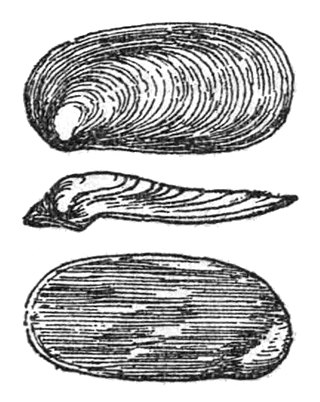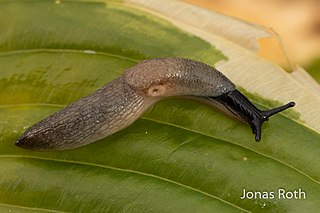Arion lusitanicus, also known by its common name Portuguese slug, is a species of air-breathing land slug, a terrestrial pulmonate gastropod mollusk in the family Arionidae.

Tandonia budapestensis is a species of air-breathing, keeled, land slug, a shell-less terrestrial gastropod mollusks in the family Milacidae.

Deroceras reticulatum, common names the "grey field slug", "grey garden slug", and "milky slug", is a species of small air-breathing land slug, a terrestrial pulmonate gastropod mollusc in the family Agriolimacidae. This species is an important agricultural pest.

Agriolimacidae is a family of small and medium-sized land slugs, or shell-less snails, terrestrial pulmonate gastropod mollusks.
Geomalacus is a genus of large air-breathing land slugs, terrestrial pulmonate gastropod mollusks in the family Arionidae, the roundback slugs.

Tandonia nigra is a species of air-breathing land slug, a terrestrial pulmonate gastropod mollusk in the family Milacidae.

Tandonia is a genus of air-breathing, keeled, land slugs. These are shell-less terrestrial gastropod mollusks in the family Milacidae.

Tandonia rustica is a species of air-breathing, keeled, land slug, a shell-less terrestrial gastropod mollusc in the family Milacidae.

Boettgerilla pallens, common name the worm slug, is a European species of air-breathing land slug, a terrestrial pulmonate gastropod mollusk in the family Boettgerillidae.

Succinella oblonga is a species of air-breathing land snail, a terrestrial pulmonate gastropod mollusc in the family Succineidae.

Arion silvaticus is a species of air-breathing land slug, a terrestrial pulmonate gastropod mollusk in the family Arionidae.

Milax gagates, known by the common name greenhouse slug, is a species of air-breathing, keeled, land slug, a shell-less terrestrial gastropod mollusc in the family Milacidae.

The reproductive system of gastropods varies greatly from one group to another within this very large and diverse taxonomic class of animals. Their reproductive strategies also vary greatly, see mating of gastropods.
Geomalacus anguiformis is a species of air-breathing land slug, a terrestrial pulmonate gastropod mollusc in the family Arionidae, the round back slugs.

Mariaella is a genus of air-breathing land slugs, a terrestrial pulmonate gastropod mollusks in the family Ariophantidae.
Carpathica is a genus of air-breathing land snails, terrestrial pulmonate gastropod mollusks in the family Oxychilidae.

Krynickillus melanocephalus is a species of air-breathing land slug, a terrestrial gastropod mollusc in the family Agriolimacidae. It is an invasive species, spreading from regions around the Black Sea to Northern and Central Europe.
Tandonia lagostana is a species of keeled slug in the family Milacidae. It is endemic to the island of Lastovo in Croatia where it as last collected in 1940. There is an additional record from the Montenegro coast that requires confirmation.

Tandonia kusceri is a species of slug belonging to the family Milacidae.
Lehmannia carpatica is a species of air-breathing land slug, a terrestrial pulmonate gastropod mollusc in the family Limacidae.













